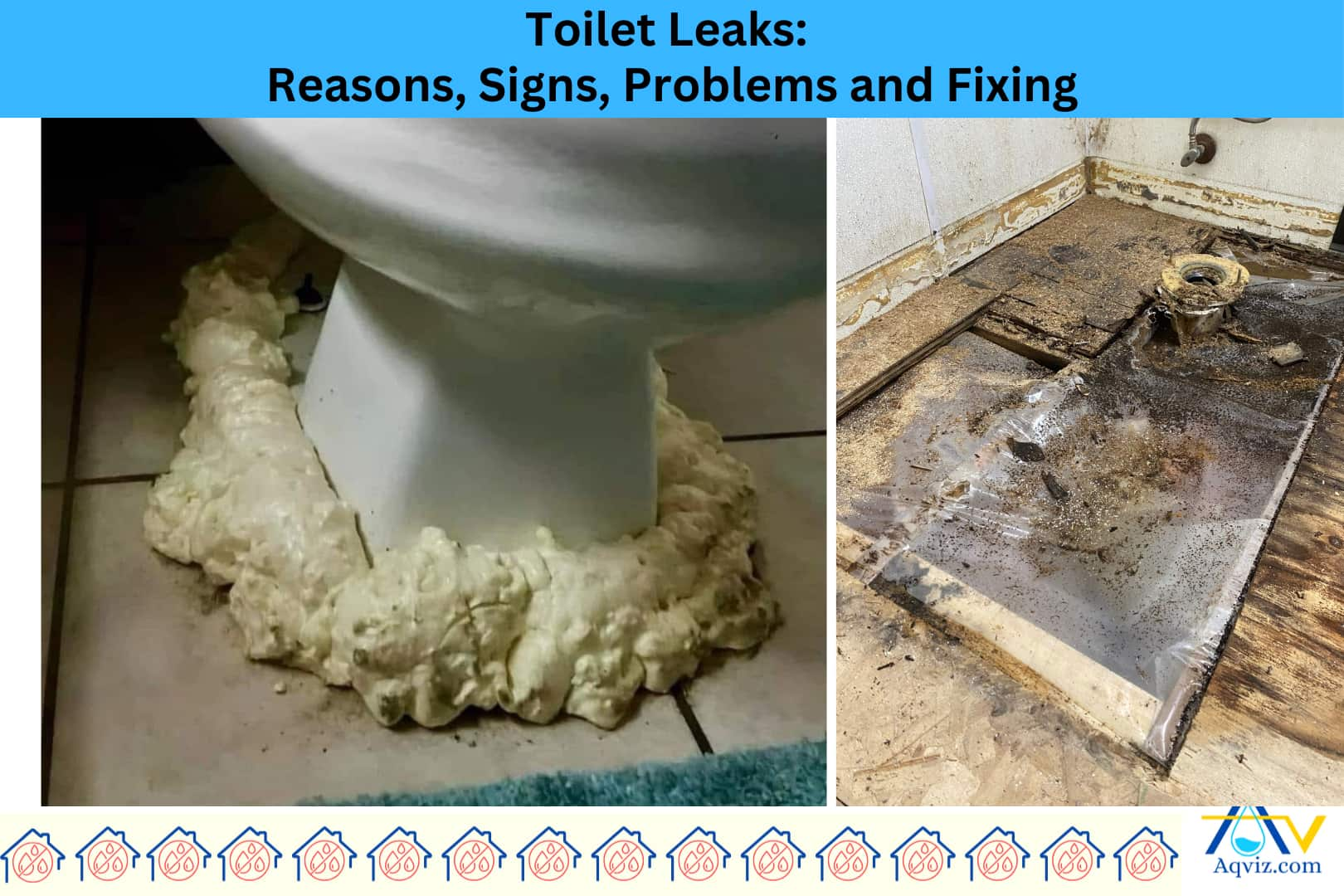All About Toilet Leak: Reasons, Signs, Problems and How to Fix

A toilet leak in the bathroom is an unintended escape of water from any part of the toilet assembly, including the tank, bowl, supply line, or wax ring seal at the toilet base. Toilet leaks usually occur due to a cracked porcelain tank, a worn flapper valve, loose fill valves, or a deteriorated wax seal where the toilet connects to the closet flange.
You can detect a toilet leak by water pooling around the base, hissing or running sound, wobbling toilet, discolored flooring or grout, and a reduced water level in the tank. When a toilet leaks, it causes these 5 problems such as subfloor damage, mold growth, water waste, structural staining, and odor issues in the bathroom.
To minimize the water damage issues due to prolonged toilet leaking, you should install a waterproofing membrane on the substrate. As well as using a high-quality wax ring, tighten the tank bolts, install a water alarm, and inspect toilet components regularly. If your toilet is leaking now, you should fix it by following the step-by-step guide. Aqviz experts have prepared a guide for the homeowners who face such that problem in the bathroom. Reach out to the Aqviz experts, and we will help you to do this successfully.

What is a Toilet Leak?
A toilet leak in the bathroom is an unintended escape of water from any part of the toilet assembly, including the tank, bowl, supply line, or wax ring seal at the toilet base. Toilet leaks usually occur due to a cracked porcelain tank, a worn flapper valve, loose fill valves, or a deteriorated wax seal where the toilet connects to the closet flange.
Toilet leaking leads to wet flooring, damaged subfloors, warped vinyl tiles, and foul odors from trapped moisture. Continuous toilet leaking causes subfloor damage, mold growth, water waste, structural staining, and odor issues.
Aqviz experts recommend using a flexible waterproof membrane beneath toilet installations, sealing pipe penetrations with polyurethane foam, and reinforcing floor seams with cementitious waterproof coating to minimize the water damage due to toilet leaking.
Read More About: Bathroom Waterproofing: Everything You Should Know
What are the Reasons for Toilet Leaks?
There are 6 reasons for toilet leaks, including a damaged wax ring seal, cracked porcelain tank or bowl, faulty fill valve, worn flapper, loose tank bolts, and leaking supply line connections.
- Damaged wax ring seal : When the wax ring seal is damaged due to drying out, cracking, or compressing unevenly, it allows water to seep under the toilet during flushing.
- Cracked porcelain tank or bowl : When hairline fractures form in the porcelain tank or toilet bowl due to impact, aging, or manufacturing defects, they allow water to leak slowly onto the floor or into wall cavities without immediate visible signs.
- Faulty fill valve : When the fill valve is worn or misaligned, it can cause continuous water flow into the toilet tank or overflow tube, leading to water waste, tank condensation, and potential drips from the tank lid or fittings.
- Worn flapper : When the rubber flapper in the toilet tank controller becomes warped, brittle, or misaligned, it fails to seal the flush valve properly, causing continuous water leakage into the bowl and triggering an overworked refill cycle.
- Loose tank bolts : When the bolts and washers securing the toilet tank to the bowl loosen or corrode in two-piece toilets, they allow water to leak from the tank base, causing visible drips around the toilet bowl area.
- Leaking supply line connections : When the flexible hose or angle stop valve connecting the water supply to the toilet loosens or develops pinhole leaks over time, it causes intermittent drips behind or beneath the toilet, often more noticeable after flushing.
How to Detect a Toilet Leak?
You can detect a toilet leak by following these 5 ways.
- Water pooling around the base : If you observe water collecting around the toilet base after flushing. This is strong evidence that the wax ring seal between the toilet and flange has failed, allowing water to escape underneath.
- Hissing or running sound : When you continuously hear a faint hissing, trickling, or running noise from the toilet tank. This is a strong signal of a leak from the fill valve, flapper, or overflow tube, wasting water internally.
- Wobbling toilet : If you feel the toilet rocking slightly when you sit or move it. This instability often proves a broken seal at the base, allowing water to leak beneath with every flush or use.
- Discolored flooring or grout : When you observe yellow, brown, or dark stains on tiles or grout joints near the toilet. This discoloration is strong evidence of ongoing leakage affecting the flooring around the fixture.
- Tank water level drop : If you occasionally detect that the tank refills without flushing. This self-activation proves water is slowly leaking from the tank into the bowl, likely due to a faulty flapper or flush valve.
What are the Problems of a Toilet Leak?
There are 5 problems due to a toilet leak, such as subfloor damage, mold growth, water waste, structural staining, and odor issues. Ongoing leaks not only affect bathroom functionality but also create serious health and building maintenance problems.
- Subfloor damage around the toilet base : Toilet leaks around the wax ring or base allow water to seep under the flooring. This hidden moisture softens plywood subfloors or cement boards, leading to warping and structural weakness.
- Mold growth behind or under the toilet : Toilet water leaks into closed or unventilated areas, promoting dampness behind walls or inside flooring. These wet zones support mold and mildew, which negatively impact indoor air quality.
- Water waste and high utility bills : A leaking toilet can silently waste hundreds of gallons per day through faulty valves or flappers. This causes a significant increase in water bills and reduces plumbing system efficiency.
- Stains on surrounding surfaces : Toilet leaks often cause yellowish or brownish water stains on tiles, grout, or walls. These marks degrade the appearance of the bathroom and are difficult to clean without repairs.
- Odor and sanitation issues : Toilet leaks, especially from the base or sewer connection, release unpleasant odors into the bathroom. These smells indicate unhealthy conditions and can lead to serious sanitation concerns if ignored.
How to Minimize the Impact of a Toilet Leak?
To minimize the impact of a toilet leak, you should waterproof the toilet installation zone and take preventive plumbing measures. Here are 5 effective methods to reduce water damage caused by toilet leaks.
- Waterproof around the toilet base : Apply a cementitious waterproofing membrane beneath the toilet and seal the edges with polyurethane sealant to stop water from seeping into the subfloor. This method prevents structural damage and mold caused by wax ring failures or base leaks.
- Use high-quality wax ring or rubber seal : Install a durable wax ring or rubber gasket during toilet installation to prevent leakage between the toilet base and flange. A strong seal helps stop dirty water from escaping onto the floor.
- Tighten tank bolts and supply lines : Check and tighten tank bolts, fill valve nuts, and supply line connectors to stop leaks from joints. This routine task helps reduce the risk of water dripping behind the toilet or under the tank.
- Install water alarm sensors : Place a leak detection sensor near the toilet base to alert you immediately if water escapes. This early warning system helps minimize water exposure and repair costs.
- Inspect toilet components regularly : Examining the flapper, fill valve, and overflow tube for wear or misalignment helps to detect silent leaks. Timely replacements help to prevent water waste and hidden damage.
How to Fix a Toilet Leak?
To fix a toilet leak, you should follow the 6-step guide below . At Aqviz, we use this method on all toilet repair jobs to ensure watertight sealing, proper fitting, and safe functionality.
- Turn off the water supply and drain the tank: First, you should shut off the angle valve connected to the toilet and flush it to empty the tank. Then, you should use a sponge or shop vacuum to remove any leftover water. This step prevents spills and gives a clean, dry work area.
- Inspect where the leak is coming from: Then check for leaks at the base, tank-to-bowl connection, and supply line using a dry cloth and mirror inspection tool. Identifying the exact location helps determine whether it’s a wax ring failure, a faulty flapper, or loose bolts.
- Tighten or replace tank-to-bowl hardware: If the leak is between the tank and bowl, you can use a wrench set to tighten or replace the tank bolts, rubber washers, and gasket. You should always use brass or stainless steel bolts to prevent future corrosion and leaks.
- Replace the wax ring at the base: If water leaks from under the toilet, you should remove the toilet by unbolting it with a socket wrench and lifting it using a toilet carrier or dolly. Then, you should scrape off the old wax ring and install a new wax or rubber seal before resetting the toilet.
- Check and tighten the water supply line: Using adjustable pliers, you should ensure the flexible braided hose from the valve to the tank is tightly secured and free of cracks. If the hose is old or worn, you can replace it with a new reinforced supply line.
- Turn on water and test for leaks: After all repairs, you can reopen the valve and flush several times, using paper towels to check for any residual drips. You can also apply tissue around the base and tank bolts to verify that the leak has been completely resolved.

Aqviz Experts have investigated all of the bathroom water damages and listed out the 8 most common water damage in the bathroom and prepared a complete guide for each water problem with including reasons, signs, problems, and how to fix it properly as an expert. So we highly recommend you to refer to all of these 8 bathroom problems.
- Bathroom Sink Drain Leak
- Bathroom Faucet Leak
- Hot Water Leak
- Bathroom Sink P Trap Leak
- Bathtub Overflow
- Cracked Shower Tray
- Bathroom Broken Tiles
- Bathroom Mold
Should You Install a Toilet After Waterproofing?
Yes, always install the toilet after waterproofing the bathroom floor. First, apply a cementitious or liquid waterproofing membrane over the bathroom floor, around the closet flange area. This seals the subfloor and prevents water intrusion from wax ring leaks or accidental overflows due to toilet.
What Size Pipe is Good for a Toilet?
The ideal pipe size for a toilet drain is 3 inches (75 mm) in diameter. For higher flow or multiple fixtures on one line, we use 4 inches (100 mm). At Aqviz, we follow standard plumbing codes and use PVC or cast iron pipes with proper slope to prevent clogs and ensure smooth waste flow.
What Causes Toilet Base Cracking?
Toilet base cracking usually happens due to improper installation, over-tightened bolts, movement due to an uneven subfloor, or heavy impacts like dropping tools or standing on the rim.
Why Does a Toilet Base Get Flooded?
The toilet base gets flooded due to a damaged wax ring, loose bolts, or a blocked drain line. More than that, an improperly leveled bathroom floor also may cause standing water near the toilet base. Prolonged toilet base flooding can cause the water to substrate and increase the water damage to the structure.
